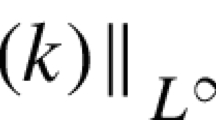Abstract
The macroscopic study of hydrodynamic turbulence is equivalent, at an abstract level, to the microscopic study of a heat flow for a suitable mechanical system (Ruelle, PNAS 109:20344–20346, 2012). Turbulent fluctuations (intermittency) then correspond to thermal fluctuations, and this allows to estimate the exponents \(\tau _p\) and \(\zeta _p\) associated with moments of dissipation fluctuations and velocity fluctuations. This approach, initiated in an earlier note (Ruelle, 2012), is pursued here more carefully. In particular we derive probability distributions at finite Reynolds number for the dissipation and velocity fluctuations, and the latter permit an interpretation of numerical experiments (Schumacher, Preprint, 2014). Specifically, if \(p(z)dz\) is the probability distribution of the radial velocity gradient we can explain why, when the Reynolds number \(\mathcal{R}\) increases, \(\ln p(z)\) passes from a concave to a linear then to a convex profile for large \(z\) as observed in (Schumacher, 2014). We show that the central limit theorem applies to the dissipation and velocity distribution functions, so that a logical relation with the lognormal theory of Kolmogorov (J. Fluid Mech. 13:82–85, 1962) and Obukhov is established. We find however that the lognormal behavior of the distribution functions fails at large value of the argument, so that a lognormal theory cannot correctly predict the exponents \(\tau _p\) and \(\zeta _p\).
Similar content being viewed by others
Notes
A different concept of temperature in the study of turbulence has been introduced by B. Castaing [4], as kindly pointed out by F. Bouchet, but Castaing’s temperature is conserved along the cascade, contrary to the situation considered here.
While the \(|\mathbf{v}_{(n+1)j}|^3/\ell _{n+1}\) fluctuate, their sum over \(j\) is fixed (\(\sim \) total energy flux in \(C_{ni}\)) so that very large values of \(V\) are forbidden in \((2)\). This is related to the fact that fixing the average of the “energies” \(|\mathbf{v}_{(n+1)j}|^3\) corresponds to a microcanonical ensemble, which is only asymptotically equivalent to the canonical ensemble \((2)\), but the approximation should be good for moderate \(V\) and large \(\kappa \).
Notice that \(\Phi _\Delta \) is a convolution product with respect to the variable \(u\): replacing \(\sum u_k\) by \(u_n\) replaces \(N-1\) factors of this convolution product by a Dirac \(\delta \).
References
Anselmet, F., Gagne, Y., Hopfinger, E.J., Antonia, R.A.: High-order velocity structure functions in turbulent shear flows. J. Fluid Mech. 140, 63–89 (1984)
Beck, C.: Chaotic cascade model for turbulent velocity distributions. Phys. Rev. E 49, 3641–3652 (1994)
Benzi, R., Paladin, G., Parisi, G., Vulpiani, A.: On the multifractal nature of fully developed turbulence and chaotic systems. J. Phys. A 17, 3521–3531 (1984)
Castaing, B.: The temperature of turbulent flows. J. Phys. II France 6, 105–114 (1996)
Frisch, U., Parisi, G.: On the singularity structure of fully developed turbulence. In: Ghil, M., Benzi, R., Parisi, G. (ed.) Turbulence and Predictability in Geophysical Fluid Dynamics, pp. 84–88. North-Holland, Amsterdam (1985)
Gallavotti, G.: Foundations of Fluid Mechanics. Springer-Verlag, Berlin, 2005 (see Section 6.3)
Kolmogorov, A.N.: The local structure of turbulence in incompressible viscous fluid for very large Reynolds number. Dokl. Akad. Nauk SSSR 30, 301–305 (1941)
Kolmogorov, A.N.: On degeneration (decay) of isotropic turbulence in an incompressible viscous liquid. Dokl. Akad. Nauk SSSR 31, 538–540 (1941)
Kolmogorov, A.N.: Dissipation of energy in locally isotropic turbulence. Dokl. Akad. Nauk SSSR 32, 16–18 (1941)
Kolmogorov, A.N.: A refinement of previous hypotheses concerning the local structure of turbulence in a viscous incompressible fluid at high Reynolds number. J. Fluid Mech. 13, 82–85 (1962)
Meneveau, C., Sreenivasan, K.R.: Simple multifractal cascade model for fully developed turbulence. Phys. Rev. Lett. 59, 1424–1427 (1987)
Ruelle, D.: Hydrodynamic turbulence as a problem in nonequilibrium statistical mechanics. PNAS 109, 20344–20346 (2012)
Schumacher, J., Scheel, J., Krasnov, D., Donzis, D., Sreenivasan, K., Yakhot, V.: Small-scale universality in turbulence. Preprint (2014)
Stresing, R., Peinke, J.: Towards a stochastic multi-point description of turbulence. New J. Phys. 12, 103046+14 (2010)
Yakhot, V.: Pressure-velocity correlations and scaling exponents in turbulence. J. Fluid Mech. 495, 135–143 (2003)
Acknowledgments
I am indebted to Christian Beck and Victor Yakhot for useful interaction during the preparation of this paper, and to Giovanni Gallavotti for earlier discussions; VY communicated reference [13] which is essential here. This work was initiated while I visited the Isaac Newton Institute in Cambridge, UK, at the end of 2013.
Author information
Authors and Affiliations
Corresponding author
Rights and permissions
About this article
Cite this article
Ruelle, D. Non-Equilibrium Statistical Mechanics of Turbulence. J Stat Phys 157, 205–218 (2014). https://doi.org/10.1007/s10955-014-1086-8
Received:
Accepted:
Published:
Issue Date:
DOI: https://doi.org/10.1007/s10955-014-1086-8




